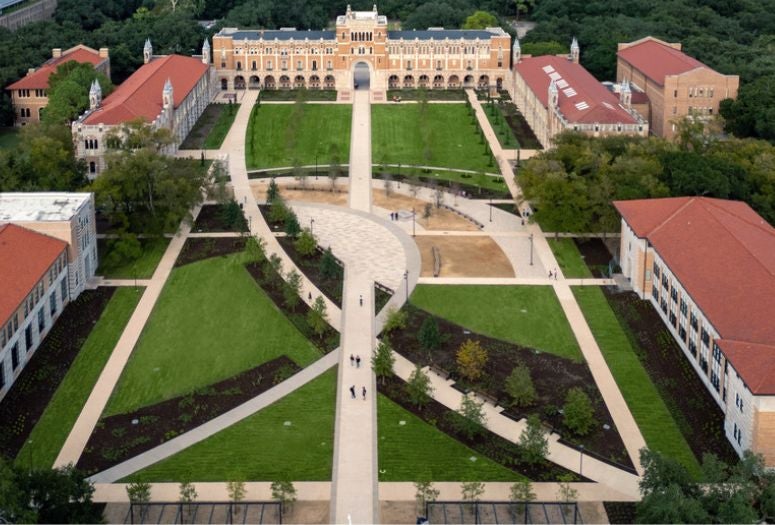
After a careful and collaborative process of strategic planning, community input and construction, Rice University unveiled its newly reimagined Academic Quadrangle during a historic reopening and ribbon-cutting celebration Sept. 12. One of the university’s most iconic, treasured spaces, the inviting and vibrant four-acre landscape now offers versatile areas designed for a wide range of activities, encouraging connection, reflection and personal growth. No longer a space to simply pass through, the new quad is now a destination, university officials said.
A long, curving path, flanked by Monterrey oak trees and native plants, stretches the length of the quad, guiding visitors through three distinct zones for ceremonial events, daily campus life and community gatherings. Designed by renowned landscape architecture firm Nelson Byrd Woltz, the updated quad, located between Lovett Hall and Fondren Library, signifies a new chapter for the university.
“We intended for the redesigned Academic Quadrangle to both fully acknowledge the history of our founding and generous founder, William Marsh Rice, and to mark and celebrate the important evolution and growth of our university over time,” said Robert T. Ladd ’78, chairman of the Rice Board of Trustees. “The new quad also supports the university’s efforts to highlight the many voices that reflect the diversity of Rice, and it creatively dedicates welcoming areas to be centers for student community life.”

The ceremonial zone, starting at the Sallyport, is designed for formal university events and features an expanded paved area, using materials that complement the historic architecture of Lovett Hall, the university’s oldest building. The area can accommodate seating for up to 3,000 people. Although it maintains the essence of the original design, the space now includes colorful beds of grasses and flowering plants on either side, which will help manage storm water and attract wildlife.
The Founder’s Memorial statue of William Marsh Rice has been relocated from the center of the quad to a paved limestone terrace at the intersection of Lovett and Sewall halls, surrounded by a garden in the ceremonial zone. The placement allows for traditions to continue to evolve into the modern era while honoring the philanthropic gift that founded the university.
“As we stand here today, we celebrate not just a new physical space but the opportunities it represents,” Rice President Reginald DesRoches said. “The new quad will serve as a focal point for the Rice experience — a place where creativity, learning, community and reflection intersect. It will support our mission to provide a world-class education while nurturing the well-being and connectivity of our campus community.”
“As we move forward, let us embrace this new space with the same spirit of curiosity, collaboration, community and caring that defines Rice. Let the Academic Quad be a place where great ideas are born, where partnerships are formed and where every member of the community can find inspiration and connection,” he said.

At the center of the quad, the commons zone invites engagement and features a central plaza with long, curving benches shaded by surrounding trees. The focal point is a granite platform, repurposed from the Founder’s Memorial, engraved with a quotation from John F. Kennedy’s famous “We choose to go to the Moon” speech given at Rice Stadium in 1962. This area is designed to host speeches, performances, protests and debates.
The community zone on the east side of Fondren Library is meant for informal gatherings and features two large pergolas within a grove of loblolly pines. The pergolas are covered with fabric that echoes the red roofs of nearby buildings, creating a canopy over long community tables where students can work and socialize. The space includes power outlets and Wi-Fi to meet students’ needs.
“We transformed this landscape from a place to move through, to a destination to seek out. It is a welcoming heart of the community that also reflects the university’s21st-century values of inclusivity, truth-telling and belonging,” said Thomas Woltz, senior principal of NBW. “The redesign offers a thoughtful example of the evolving dynamic uses and prevailing narratives of community, commons and ceremony, in a space where minds and lives are shaped in academia.”
The quad’s redesign, spurred by the Task Force on Slavery, Segregation and Racial Injustice commissioned by then-Rice President David Leebron in 2019, was shaped by four years of academic research and community input. The Board of Trustees announced its decision for the redesign in January 2022 after a working group led by trustee Charles Landgraf ’75 reviewed ideas and opinions from students, faculty, staff, alumni and community members, who submitted more than 1,200 comments. Trustees Elle Anderson ’01 and Gloria Tarpley ’81 as well as trustee emeritus Donald Bowers ’91, also spoke at the event.
“Today’s new quadrangle is the result of thoughtful input from every segment of the Rice community — trustees, faculty, students, staff and alumni,” former Rice president David Leebron said. “As a result of that dialogue, we have today a redesigned academic quad that incorporates a wide range of concerns and seizes the opportunity to be more inclusive, more engaging with our history and more deliberate in creating a welcoming and lively space in the academic and historic center of our campus.”
Instead of a single-species lawn, the landscape now features a wide variety of shade trees, perennials and shrubs. More than 24,000 new plants have been planted, all of them either native or adapted to the climate of Houston. Native Texas wildflowers — such as purple coneflower, mealy blue sage and Brazos penstemon — in hues of blue and purple echo Rice’s school colors, with pops of vibrant magenta creating visual interest for both humans and pollinators. More than 90 trees were added, and two large mature oaks at the west end of the quad were preserved and used to determine the landscape’s ecology.

For more information on the quad please visit the dedicated website here.

